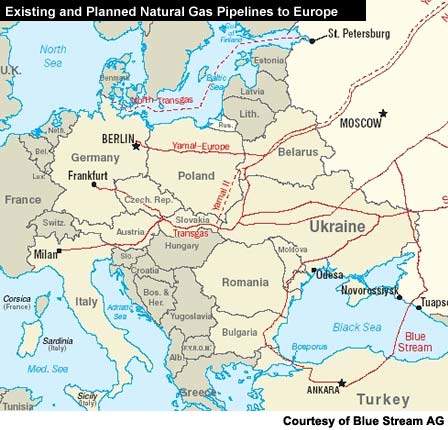
The Blue Stream pipeline project is a major gas pipeline carrying natural gas from Russia to Turkey across land and the Black Sea (to diversify Russian gas routes). The pipeline is owned and operated by Blue Stream Pipeline BV, which is a Netherlands joint venture between Gazprom of Russia and Eni of Italy.
The joint venture owns the sea section of the pipeline and the Beregovaya compressor station. Gazprom owns the section of the pipeline on Russian territory and BOTAS owns the section of the pipeline on Turkish territory.
Construction started in 2001-02 and the pipeline was inaugurated in November 2005 (a new extension is now planned). The original pipeline cost $3.4bn to built (the subsea section cost $1.7bn) and used pioneering pipe-laying methodology.
Blue Stream reached its full design capacity of 16 billion cubic metres of gas a year by 2010. By August 2011, it was carrying 62 billion cubic metres of gas.
Blue Stream background
Russia made an agreement with Turkey in 1997 to supply around 364.5 billion cubic metres of gas from 2000 to 2025. There was an existing pipeline route that crossed several countries including the Ukraine, Moldova, Romania and Bulgaria.
However, according to Russia this route would make the gas more expensive and there were allegations that the gas would be illegally tapped from the pipeline as it passed through these countries – particularly through Moldova and Ukraine.
A new pipeline (Blue Stream) was planned that would avoid all of these countries and remain solely on Russian and Turkish soil and cross the Black Sea.
Although there have been political rumblings over the pipeline, it was completed and has become a success. Turkey no longer needs all the gas it signed up for and can export a proportion of it.
Pipeline construction
The engineering, procurement, construction and installation contract was awarded to Saipem (an Eni subsidiary). The steel pipe for the project was provided by suppliers including Corus, Nippon Steel, Sumitomo, NKK and Klawasaki Steel. The pipe was coated by BSR in Hartlepool, UK, and Bredero Price Coaters in Leith, Scotland).
There are three main sections to the pipeline: a 222-mile section in Russia; a 235-mile section under the Black Sea (some as far down as 2km); and a 300km section in Turkey.
The pipeline route runs from the Izobilnoye gas plant to Dzhugba (222 miles) and includes the Stavropolskaya and Krasnodarskaya compressor stations and the Beregovaya compressor station in Arkhipo-Osipovka; Dzhugba to Samsun (Durusu Terminal 40 miles from Samsun) across the Black Sea (235 miles); and Samsun to Ankara (300 miles).
For the Black Sea section, the shallow-water sections (380m) were laid by Castoro Otto, while the deeper sections were laid by Saipem 7000 (J-lay method, which causes less stress).
The pipeline was laid in different diameters in various regions, with a 1,400mm pipe for the main land section, a 1,200mm pipe across mountain regions and a 610mmpipe in the subsea sections (in the subsea section the pressure of gas is around 250atm).
Blue Stream extension
There has been much discussion about extending the Blue Stream pipeline to carry Russian gas further into Europe. As early as August 2005, President Vladimir Putin advocated the extension of Blue Stream through Bulgaria, Serbia and Croatia to Western Hungary, although there is a competing project – the Nabucco Pipeline (a consortium of European countries trying to avoid so much reliance on Russian gas).
Construction of the second phase of Blue Stream will give Russia the scope to expand the gas exports to the west (to regions of Central Europe via the new planned Turkey-Bulgaria-Serbia-Croatia-Hungary pipeline), and then to the south via the Samsun-Ceyhan gas pipeline to Israel and Lebanon.
In June 2006, Gazprom and MOL of Hungary signed an agreement to carry out a study into the plans to extend Blue Stream towards the south (Turkey to southern Europe). Hungary would act as a distribution centre in the Balkans for Russian gas, and there would be gas storage facilities for at least ten billion cubic metres of natural gas. The project has been costed at around €5bn ($6.3bn).
The extension of Blue Stream towards Hungary is a definite alternative to Nabucco, which will not begin construction until 2013.

